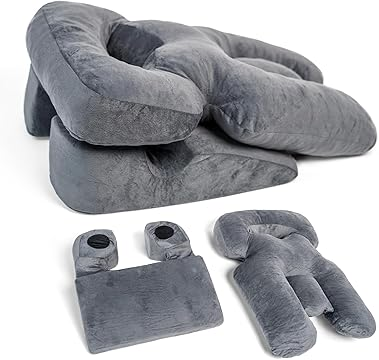The significance of comfortable and well-supported positioning for individuals spending considerable time in bed cannot be overstated. It transcends mere comfort, playing a pivotal role in safeguarding skin integrity and promoting overall well-being. Neglecting proper alignment and pressure distribution can lead to a cascade of issues, the most concerning being the development of pressure ulcers, commonly known as bedsores. These debilitating wounds can cause significant pain, increase the risk of infection, and prolong recovery periods. Understanding the mechanics of pressure and the proactive measures available is paramount for both individuals and their caregivers.
Understanding the Genesis of Pressure Ulcers
At its core, the challenge lies in the sustained pressure exerted on specific areas of the body when lying in one position for an extended duration. This constant compression impedes the vital flow of blood to the skin and the underlying tissues. Blood carries essential oxygen and nutrients necessary for cellular health and repair. When this supply is restricted, the tissues become oxygen-deprived and are at a heightened risk of damage and breakdown. This is the genesis of a bedsore, a localized injury to the skin and/or underlying tissue, typically over a bony prominence.
The most susceptible areas are those where bony structures are close to the skin surface and bear the weight of the body against the bed. These include the heels, ankles, hips, tailbone (sacrum), elbows, shoulders, and the back of the head. The severity of bedsores can range from superficial redness that resolves with pressure relief to deep wounds that may involve muscle and bone, requiring extensive and prolonged treatment.
Are you seeking ways to enhance comfort and proactively protect skin health during extended rest?
The Cornerstone of Prevention: Repositioning and Supportive Aids
The primary strategy for pressure ulcer prevention lies in the consistent practice of repositioning. Regularly altering one’s posture, even by small degrees, effectively redistributes pressure away from vulnerable areas. For individuals with limited mobility, establishing and adhering to a structured turning schedule is critical. This schedule typically involves repositioning every two hours, or more frequently depending on individual risk factors and skin assessment. These turns can involve shifting from the back to either side, or to a prone (on the stomach) position if medically appropriate.
However, manual repositioning alone can be challenging and may not always provide sufficient pressure relief. This is where the strategic use of supportive aids comes into play. These specialized devices are engineered to gently elevate and cradle specific parts of the body, effectively offloading pressure from bony prominences. They work by increasing the surface area over which the body’s weight is distributed, thereby reducing the concentrated pressure on any single point.
A variety of supportive positioning products are available, each designed to address different needs and anatomical locations:
- Wedge pillows: Can elevate the upper body, providing support for the back and reducing pressure on the sacrum and hips. They can also be placed under the knees to relieve pressure on the heels.
- Body pillows: Offer full-length support and can aid in maintaining side-lying positions, preventing direct pressure on the hips and shoulders.
- Heel elevation pillows or protectors: Specifically designed to lift the heels entirely off the bed surface, a crucial step in preventing heel ulcers.
- Elbow protectors: Cushion and offload pressure from the bony prominences of the elbows.
- Smaller positioning pillows: Can be strategically placed under the hips, knees, or ankles to provide targeted pressure relief and maintain proper alignment.
The choice of supportive aids should be tailored to the individual’s specific needs, considering factors such as their level of mobility, body size and shape, the presence of existing pressure ulcers, and any specific areas identified as high-risk. Consulting with healthcare professionals, including doctors, nurses, and physical or occupational therapists, is invaluable in determining the most appropriate types and placement of these aids.
Discover the transformative impact of supportive positioning on skin health and overall comfort.
A Holistic Approach to Skin Health and Comfort in Bed
Beyond the use of supportive aids and regular repositioning, a comprehensive prevention strategy for bedsores includes several key elements:
- Specialty Mattresses: Support surfaces designed for pressure redistribution, such as air mattresses or foam mattresses with zoned support, can further enhance pressure relief and contribute to a more comfortable environment.
- Proper Hygiene: Keeping the skin clean and dry helps to maintain its integrity and reduce the risk of breakdown.
- Nutrition and Hydration: Adequate nutrition, particularly sufficient protein intake, provides the building blocks necessary for skin repair. Hydration also plays a crucial role in maintaining skin elasticity and resilience.
- Education and Awareness: Caregivers and individuals spending extended time in bed should be well-informed about the risks of bedsores, the importance of regular repositioning, and the proper use of supportive aids.
By integrating these practices, you can create an environment that significantly reduces the risk of pressure ulcers and greatly enhances the comfort and skin health of individuals on extended bed rest.
Prioritizing Proactive Care for Long-Term Well-being
In conclusion, prioritizing proper bed positioning is not merely about comfort; it is a fundamental aspect of maintaining skin health and preventing the debilitating complications of pressure ulcers. Through consistent repositioning, the strategic use of a variety of supportive aids, the selection of appropriate support surfaces, and attention to overall skin health, individuals can significantly reduce their risk and enhance their quality of life. Taking these proactive steps is an investment in long-term well-being and a testament to the power of attentive and informed care.
Ready to take the next step in ensuring optimal comfort and skin protection?
Affiliate Information
At Serenity Wellness Foundation, we help women recovering from surgery by providing essential information, resources, and guidance on effective recovery strategies so they experience a more comfortable, informed, and stress-free healing journey—so that they can regain their strength, confidence, and well-being, empowering them to return to their lives with ease and dignity.
To help sustain our educational efforts and outreach programs, we may participate in select affiliate partnerships. When you make a purchase through one of our affiliate links, a portion of the proceeds supports our nonprofit mission—at no additional cost to you.
Your support directly helps us create and share trusted recovery information, expand access to healing resources, and empower more women with the knowledge they need to navigate post-surgery life with clarity and confidence.
Thank you for being part of our mission to make recovery more informed, accessible, and empowering for every woman.
With gratitude,
The Serenity Wellness Foundation Team


